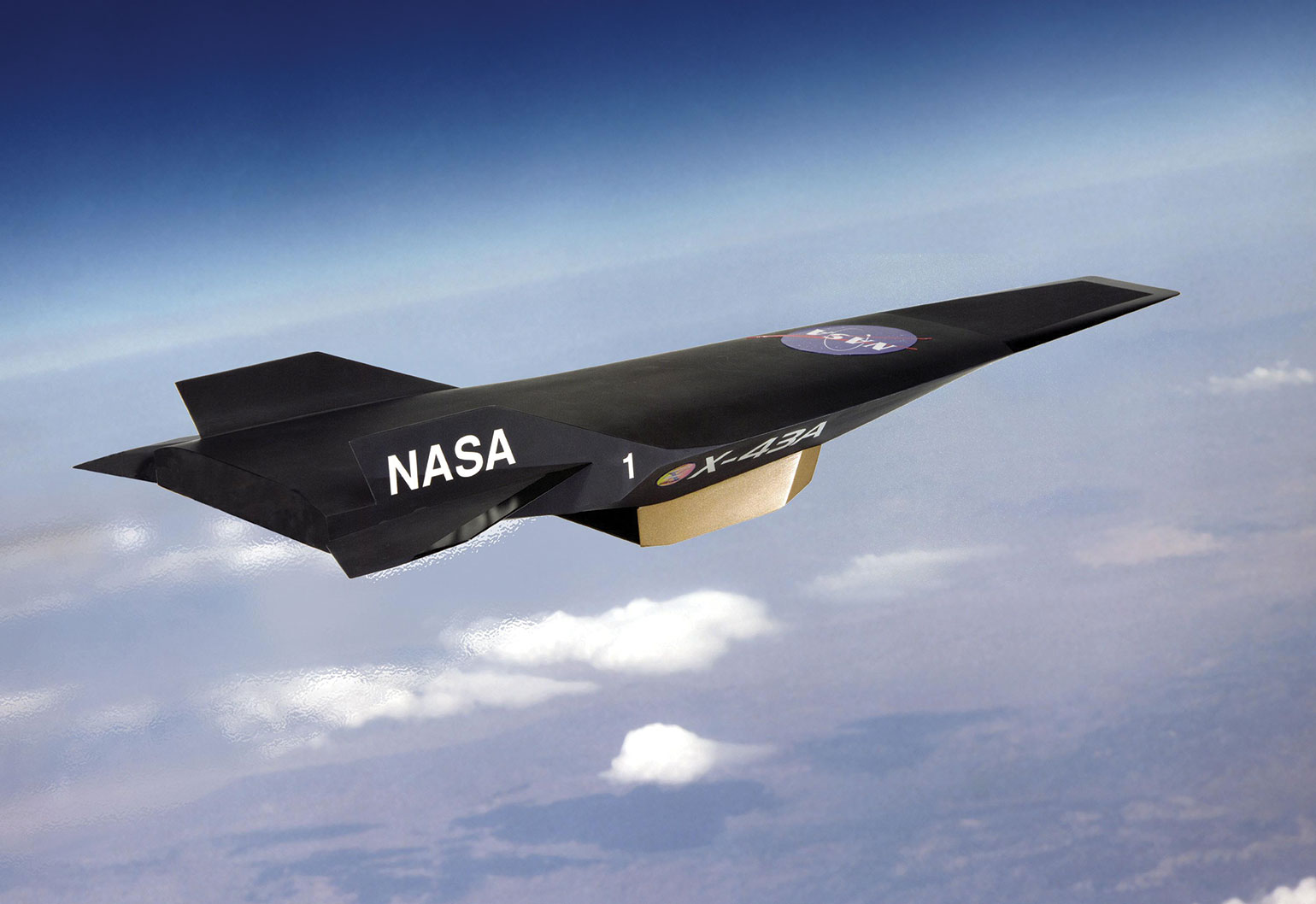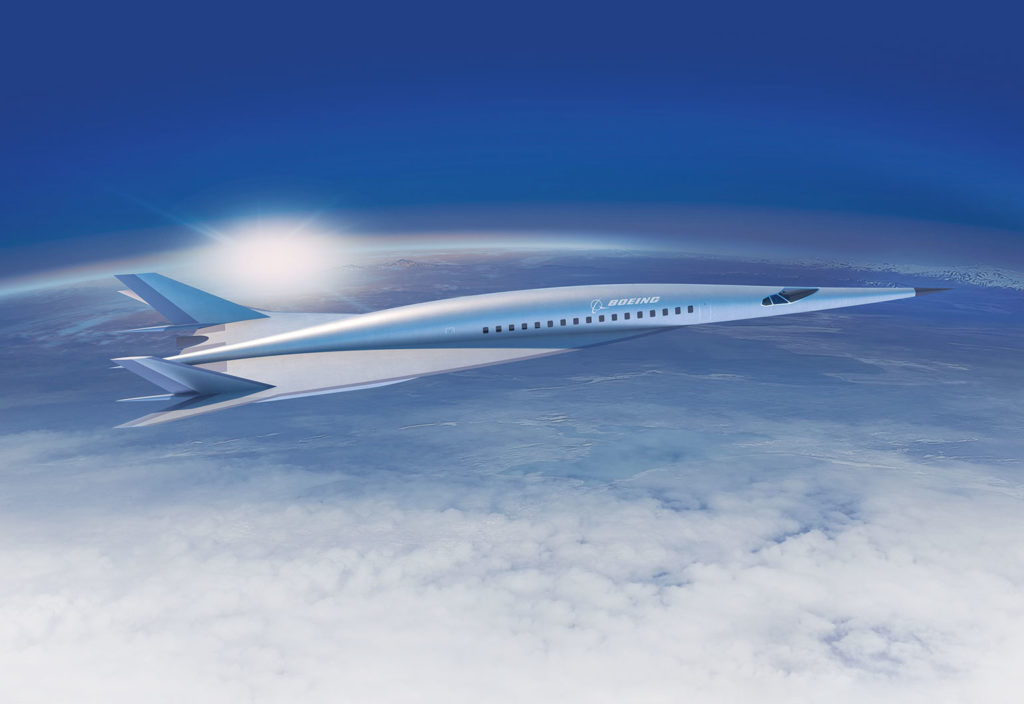As a concept, the hypersonic scramjet has been around since the 1960s, but engineers only now have the material to realise its potential as the future of air travel.
To test its experimental X-43A — an unmanned, single-use, scramjet-powered, hypersonic aircraft of which three were built — NASA piggybacked it on two other aircraft.
First was the Boeing B-52 Stratofortress, which carried under its wing the other two vehicles to an altitude at which they could be ‘drop-launched’.
Then there was the booster rocket, a modified version of a Pegasus rocket, which would accelerate the X-43A after the drop launch to a speed at which its scramjet engine could operate.
The first test flight, in 2001, failed when the booster rocket lost control.
The second, in March 2004, was a success: the scramjet-powered X-43A flew 24 km in 11 seconds at a top speed of Mach 6.83 (8433 km/h).
But it was the third test that really showed the potential of scramjets.

On 16 November 2004, the third X-43A set an astounding, new air-speed record of Mach 9.6 — 11,854 km/h — at an altitude of 33,500 m.
The flight distance from Sydney to London is just more than 17,000 km. The X-43A, if it were able to sustain such performance over that distance, would make the trip in around 90 minutes. But that’s a big leap into the future.
“It took about 50 years to develop scramjet technology to the point it could be demonstrated in flight,” said Dr Kevin Bowcutt, Boeing Senior Technical Fellow and Chief Scientist of Hypersonics.
“It took so long because of the extreme thermal environment encountered at hypersonic speeds and the challenges of ground testing at hypersonic speed due to high flow energy and temperature. Hypersonic flow physics are also difficult to analyse theoretically or simulate in computers.”
Scramjets have required materials that could withstand the extreme heat created at such speed. The scramjet — from ‘supersonic combustion ramjet’ — only becomes operational at around Mach 5, or five times the speed of sound (more than 5000 km/h).
Rather than using turbofan blades to compress air before combustion, scramjets use the forward speed of the aircraft. It is an air-breathing beast that has presented some fascinating engineering challenges.
Up to speed
Thanks to research bodies such as those at the University of Queensland (UQ), the University of New South Wales (UNSW) Canberra and the Royal Melbourne Institute of Technology, Australia has remained at the forefront of certain areas of scramjet design and engineering.
“Scramjet engines don’t just have fewer moving parts, they have no moving parts at all,” said Professor Michael Smart, mechanical engineer, director of Hypersonix and head of UQ’s HyShot Group.
This would make them easier to engineer, yes?
“No! Things get very hot when they’re travelling at that speed,” he said.
“Up until about 10 years ago, people were trying to use metallic materials for scramjet construction, like titanium and nickel alloys — high-temperature alloys from the aerospace industry. But those materials just didn’t have the capability.”
The materials that do have the capability to withstand the extreme operating temperatures, Smart said, are carbon composites.
“These are materials like fibreglass, but instead of having polymer fibres, they have carbon fibres,” he explains.
“The epoxy matrix is not like typical fibreglass. Instead it uses materials like silicon carbide as the matrix. Those carbon composites can withstand temperatures up to 1600 degrees Celsius and not be damaged. They have been around for a long time, but what has really changed in the last decade is our ability to fabricate them in all sorts of aerodynamic shapes.”
A secondary challenge is the complexity of the flow structures in hypersonic flight, said Professor Russell Boyce, Director of UNSW Canberra Space.
“It is beautiful science, but at the same time it is very complex,” Boyce said.
“You can turn nice, well-behaved and well-understood flow into disaster flow in milliseconds, depending on the physics, and depending on what you do with the aircraft.
“With a rocket, the aerodynamics is easy — you just put a heat shield on the front. It is long and slender and apart from the fins, there’s nothing sticking out into the flow. The engine is not air-breathing, so nothing flows in. It’s just a nice, self-contained combustion challenge. Scramjets are the opposite.”
Other challenges are numerous.
The size of the engine, the rate at which chemical combustion occurs, the temperature, the fuel type, the altitude and therefore air pressure and oxygen mix — they all affect design and engineering.
“Designing ramjet and scramjet inlets and nozzles are challenging both aerodynamically, in terms of shape, and structurally,” Bowcutt said.
“For a ramjet or scramjet that operates over a speed range greater than about one Mach number, inlets and nozzles must employ variable geometry to efficiently compress the ingested air and expand the engine exhaust respectively. This is particularly challenging because the inlet and nozzle structures, and the seals they employ, get very hot and must be made of special, high-temperature materials.
“Cooling the internal engine structure with fuel is also required. In a scramjet, designing and fabricating fuel injectors that mix most of the fuel with air is challenging. It must be able to ignite combustion and keep the flame burning. It’s also necessary to keep combustion pressure contained in the engine because it can possibly lead to what is called engine ‘unstart’.”
Space to grow
Where are scramjet and related technologies likely to be used?
Boeing is working on civilian and military applications, and Australian researchers are looking towards the stars.
Traditional satellite launches involve multiple-stage rocket systems, which requires a great deal of fuel and an enormous amount of waste.
Rockets have traditionally been single-use vehicles, although experiments by Elon Musk’s private space company SpaceX and Boeing’s XSP reusable first stage, which is in development, are quickly making reusable rocket technology a reality.
Australian scientists and engineers have discussed developing a launch vehicle that uses a first-stage rocket, a second-stage scramjet and a small, third-stage rocket. The scramjet vehicle carries the third-stage rocket toward its orbit, then turns and flies back. It is reusable.
As technology develops and increasingly requires connection to a network, small satellites are providing an always-on data capability.
The cost of sending these satellites into orbit, Smart said, is a major concern for the organisations involved.
Reusable launch vehicles will reduce that cost. But whether the solution involves scramjet technology or something else is yet to be confirmed.
“The day Elon Musk landed his Falcon reusable rocket back on the launch pad was possibly the end of scramjets for access to space,” Boyce said.
“SpaceX and Blue Origin, with their approach and their reusable tech, are dropping the floor out of launch costs. The cost and complexity of developing scramjets to do the same job is too great.
“The advantage of scramjets will be long distance, constant-velocity cruise — for example, airliner-style transport — but not for a long time. The challenges in man-rating a scramjet system will be extreme.”
Boyce believes this is an important time for Australia to be getting serious about its role in space.
“Australia is a relative newcomer, with the recent development of the Space Agency,” he said.
“We’re not hindered by the baggage of 40 to 50 years of investment. And we happen to be doing it at a time that space is transforming. It’s quite a serious opportunity and there are a lot of young engineers who are getting very excited about it.”
Passenger flights
Boeing has been interested in commercialising ramjet technology in order to make the future of air travel faster and more efficient.
So, what’s the difference between a scramjet and a ramjet?
“A scramjet engine is a type of ramjet in which injected fuel is burned in a supersonic airstream within the engine,” explained Bowcutt.
“For ramjets, fuel combustion occurs in subsonic air, which is what makes it different from a scramjet.”
Ramjets and scramjets, he said, are both air-breathing jet engines that do not employ compressor blades to compress the air. Ramjets operate up to about Mach 5.
“Beyond Mach 5, air pressure and temperature become too high in the engine for it to operate at optimal levels,” Bowcutt said.
“To prevent this condition, the air is allowed to remain at supersonic speed in the engine, which by definition makes it a scramjet.
“Speed therefore dictates the type of engine used for air-breathing flight: turbofan/turbojet to about Mach 3, ramjet to about Mach 5, and scramjet beyond.”
It’s a hybrid of this technology that interests Boeing. The aerospace giant has designed a preliminary, passenger-carrying hypersonic — Mach 5 — aircraft concept, Bowcutt said, that could have either commercial or military applications.
“It employs what is called a turbo-ramjet engine, which is the integration of turbofan and ramjet engines into a combined propulsion system,” he explained.
“It would be premature to speculate when hypersonic flight for global travel will be a reality. Some of our studies show that notionally it could be feasible as early as 10 to 20 years. However, it is much more likely to be operable in the 20 to 30-year range.”
